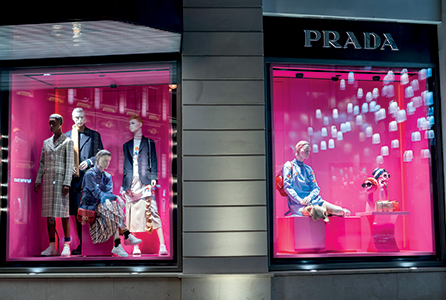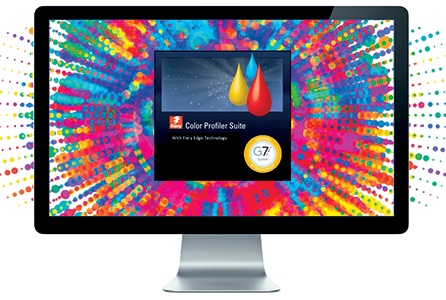
Software is available to help keep colour consistent
Living a life of colour
The industry is currently battling with a shortage of skilled workers and increased consumer demand for higher quality products and faster jobs. A surge in the wide-format print personalisation market also now means that brand specific needs are having to be met on a daily basis, as standard.
While colour management technology is a crucial aspect of the print industry, wide-format print, point-of-sale displays, banners, window graphics and other soft signage are also key areas in which colour consistency is key.
When thinking about brand specific needs, nothing tells consumers what brand they are buying from more than its signage. This is essentially the face of any brand – from the sign on the front of the shop, to promotional and wayfinding signage throughout. If the colours vary in applications such as this, it can lead to confusion and a loss of custom.

Getting the brand colours right is crucial when signage and point-of-sale displays act as the face of a business
Concerned environmentally focused consumers are also beginning to raise eyebrows at the potential for the generation of waste during the production process. Errors mean waste and losing valuable time and money due to inconsistencies and errors in colour; it is one thing that can really set a production flow back.
But it is an issue that can be kept under control with the implementation of the latest colour management software. So, what knights in shining armour are out there?
Stay on brand
EFI offers a wide variety of colour management technologies. The EFI Fiery Color Profiler suite creates calibrations and International Colour Consortium (ICC) profiles, monitors profilers (for soft proofing), aligns colour output between printers, verifies colour output against industry standards as well as custom/house standards.
The EFI ColorGuard allows users to set up re-calibration and verification schedules, ensuring that both actions are performed in time. Roland Campa, senior product line manager at EFI explains: “Verifications ensure reliable colour output in the daily production, and re-calibrations are the perfect touch point for getting ‘failed’ verifications back into the ‘passed’ state.

EFI offers a wide variety of colour management technologies
“Verification data is uploaded and displayed through the cloud and allows users to take intelligent business decisions by setting up meaningful schedules for both re-calibrations and verifications. One can also create reports and labels of the verification to demonstrate the colour stability to customers as a value-add.”
The third technology offered by EFI is Fiery SpotPro which allows users to reproduce standard spot colours, or custom spot colours.
On why it is so important to maintain colour consistency, Campa explains: “Hitting brand colours as close as possible is an important criterion for brand identification. If your brand colours have a different ‘flavour’ each time you print it, customers will perceive your print product as ‘low quality’, and it might eventually affect the customers’ view on the brand itself.
“[Businesses] also have to deal with many recurring jobs. Customers expect you to print their jobs the same way you already printed them in the past. If the colours change, customers will be very unhappy. Designers invest a lot of work and passion into achieving the perfect colour appearance for their jobs. If you cannot reproduce these colour appearances with your printer, the product might not get accepted.

When you consider the high cost of substrates, ink and press time these technologies pay for themselves very quickly”
“Today 2% of the print jobs in North America and 3% of the print jobs in Europe on an average are rejected by print buyers because of inconsistent, inaccurate colour, leading to lost revenue in the hundreds of thousands of dollars per year.”
O Factoid: Today 2% of the print jobs in North America and 3% of the print jobs in Europe on an average are rejected by print buyers because of inconsistent, inaccurate colour O
Accuracy is key
Since being founded in 2002, ColorLogic has grown a portfolio of colour management technologies. The ColorLogic suite of products consists of ColorAnt which measures, corrects and optimises measurement data including the ability to edit primary colours and substrate colour using full-sized test charts. CoPrA creates ICC Printer, DeviceLink and SaveInk profiles with a user-friendly interface for any colour space.
ZePrA Smart Color Server is a colour server that uses ICC printer and DeviceLink profiles to convert colours in industry standard formats such as complex PDF documents and image file formats such as TIFF, PSD or JPEG to any desired printing condition including profile sets for international print standards and any ICC compliant workflow.
Also highlighting the importance of colour consistency in staying on brand, Barbara Braun-Metz, chief executive officer of ColorLogic says: “Without colour management, colours are just a mess because colour appearance is dependent on the inks used, the paper tints, the printer and the printer setting. Without recording all of these parameters, you have no clue how the printer prints colours.
“Brand owners demand the right colours for their logos and products. If the colours of a package on the shelf of a supermarket shifts from package to package, the perception of the client is biased and thus [they] would very likely not buy the product. Therefore, colour consistency archived with process control and colour management is crucial for any print provider and brand owner.”
GMG Color has been in operation for over 35 years and has around 150 employees working across Europe, USA, China and Japan. Newly launched on the market is the GMG OpenColor 2.3 which makes sure that colours are produced “exactly how you want them”. GMG also offers its patented and award-winning GMG OpenColour. This enables accurate proof simulation of the overprinting effects of spot colours using special multi-channel profiles.
A spokesperson for GMG Color explains: “The spectral data calculation includes printing technologies; media types and printing order and its results are so reliable that profile iterations are no longer necessary. Besides, you’re able to create profiles without a test chart with GMG OpenColor, which is an immense benefit in production.”

GMG Color technology enables accurate proof simulation of the overprinting effects of spot colours
In terms of knowing what technology is best for your business, GMG Color offers solutions for different areas of application, from sign and display printing, as well as packaging and commercial printing for the print industry.
Looking forward
So, we have looked at what type of colour management technology is available on the current market and the benefits these can bring, but where is this technology headed?
Braun-Metz describes spot colour and multicolour printing as hot topics for both colour management and digital printing in general. She elaborates: “With more and more [companies] adding orange, green and blue or violet to the equation, handling of colours gets more complex and colour management is even more needed.
“One difficulty comes from the fact that today’s standard direct-to-print applications do not properly support multicolour ICC profiles and rendering of spot colours. The increasing trend to switch to digital printing is fuelled by the industrial printing industry now printing on a variety of substrates such as ceramics, textiles, foils, and décor. Therefore, specialised colour servers such as ColorLogic, ZePrA, and Smart Color Server are crucial.”

Vibrant and consistent colours on wide-format displays can transform a brand’s image
A spokesperson for GMG Color adds: “Colour management and production processes are becoming increasingly automated. For time and the associated increases in production efficiency, it is necessary, that companies increase automation. This trend can also be seen in the area of colour management. Customers are demanding more automated processes with increasing production quality. This is one of the main challenges that are moving into focus more and more.
Your text here...